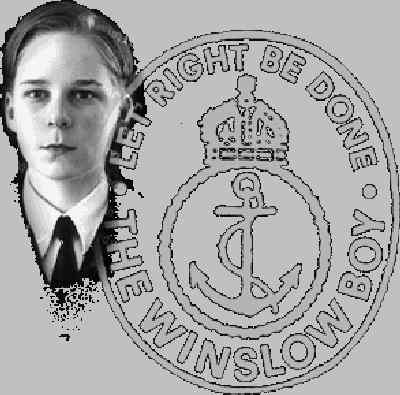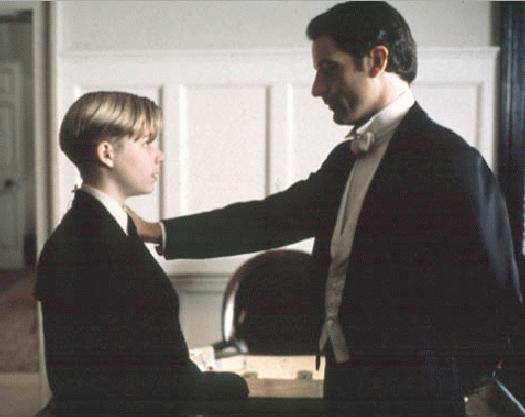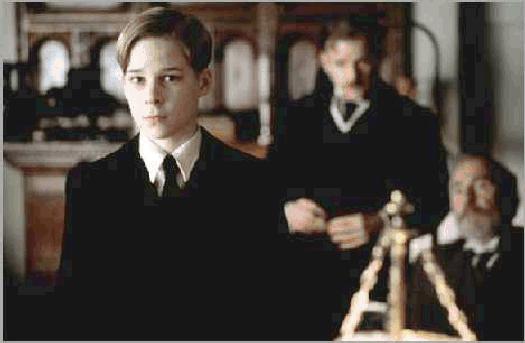
Figure 1.--Ronnie's collar and tie are not right for the 1910s, he would have worn an Eton collar. The legal maxim illustrated by the film is "Let Justice be done."


Figure 1.--Ronnie's collar and tie are not right for the 1910s, he would have worn an Eton collar. The legal maxim illustrated by the film is "Let Justice be done." |
No list of English films featuring boys and their clothing is complete without this classic. A boy at the English naval school at Osborne is accused of stealing and summarily
expelled with no real investigation of the matter. A respected lawyer agrees to take his case. Wonderfully acted and well costumed. The film underscores how the
law exists to protect even a young boy in a matter of seemingly minor imprtance. It ends with the ringing "Let justice be done." This is on my list of important films,
primarily because of the subject. I believe that one of the major reasons for the success of America and England is the system of law, imperfect as it is, protecting
individuals and their property. This film is a good illustration of the legal process. The 1999 version is a serious, well acted which unfortunately plays loose with historical accuracy.
The film is based on the celebrated play by British dramatist Terence Rattigan which was first staged in 1946. Rattigan wrote another well known play, also turned into a movie, about a schoolboy--The Browing Version. The play write was reportedly particularly fond of That Winslow Boy. "If The Browning Version is my passport to
heaven," he once said, "then The Winslow Boy is the leather wallet that contained it."
Ronnie Winslow the 12-13 year old cadet is played by Guy Edwards, although it is the title role, he actually has a rather small part in the film. Nigel Hawthorne plays the father, Rebecca Pidgeon plays the sister, and Gemma Jones plays the mother. Sir Robert Morton is played by Jeremy Northam.
A boy, Ronnie Winslow, at the English naval school at Osborne is accused of stealing a five shilling postal note and summarily expelled with no real investigation of the matter. Ronnie returns home is disgrace. The first we see Ronnie he is standing stiffly in the the carefully tended garden, despite the steady rain. He is soaking wet. He wears a navel cadet's uniform and clutches a letter explaining his expulsion. The family is first surprised to see him retuning early from school. He insists that he is innocent. His father speaks to him and asks him if he is telling the truth. "You cannot lie to me," the elder Winslow warns, "for I am your father and I shall know it." "No, Father, I didn't," Ronnie replies. His family is convinced of his innocence. The film is driven by Arthur Winslow, George's father, and his relentless search for justice. He persuades the country's leading lawyer, Sir Robert Morton to take on Ronnie's defense. Sir Robert grills the boy relentlessly and concludes that
he is telling the truth. The options were limited. It was unheard of at the time for a 13-year old boy to challenge the recered Royal Navy. The case challenges long accepted legal notions and the nations most respected institution--The Royal Navy. It causes a furor in the press and Ronnie's case becomes a cause celebre. The story is based on an actual incident at Osborne and the subsequent legal struggle in the English courts.
Osborne is of course the estate built on the Isle of Wright by Prince Albert for his growing family in the 1840s. After his death, Queen Victoria turned into a virtual mausoleum for her beloved husband. On her death, King Edward VII who did not like it, bequeathed it to the nation. It was turned into a national memorial, but part of the estate was turned into a naval training school. Formerly rotting training sdhips had been used. Early cadets included the sons of George V, including the future Edward VIII and George VI--both of whom experienced a difficult time there. The princes' dormitory was the converted stables of theor greatgrand parents.

Figure 2.--Ronnie is seen here with his barrister, Sir Robert Morton. Unfortunately you can't make out much about his suit. |
A little historical background is needed here to fully understand this film and the court case. While not directly related to fashion, it touches on several topics HBC does address, the English monarchy, cadets, Osborne, and Edwardwian era so we have decided to provide the historical details. This is especially needed as with many movies, there are many historical inaccuracies in the film.
The entire original play takes place in the drawing room of the Winslow house in South Kensington, London. Mamet's screenplay opens up the action to numerous other locations, including the House of Commons, the Horse Guards, a Suffragette's Headquarters, and Sir Robert Morton's office, giving a much wider view of Edwardian society.
The play is set in 1911 which was about the time Prince Edward (future Edward VIII) and Prince Albert (future George VI) were cadets at Osborne.
Although an elaborately costumed production, some of Ronnie's outfits appear rather modern for 1910. His cadet uniform is accurately done, but his suit and necktie is much too modern. Ronnie in fact looks like a time traveler that has been plunked down in 1911 England. In a first-class costume drama one would think that they could do better. It is true that neckties did exist in 1910. Ronnie's tie and collar are a destinctly modern cut. In addition, a 12-13 yearold boy from a conservative family almost surely would have worn a Eton collar in 1910. HBC's Eton-specialist assures us that in 1910, a well-bread boy would have worn a Eton collar until 15-16 years of age. This would havd especially been the case from a conservative family. HBC does not have a photograph of the real-life 13-year old George Archer-Shee to confirm this. We note, however, that the 1948 original film and a recent low-budget BBC production both costumed Ronnie in an Eton collar. (Actually the BBC production raises another question as to whether the Eton collar should be worn inside or outside the vest/waistcoat or coat. In the BBC production, the collar was neatly tucked away under the boy's vest.) We do not know if the modern collar and tie show here were a conscious decission or simply sloppy reserach. What ever the case, it stands out painfully in such an otherwise well-costumed film.

Figure 3.--Ronnie in his modern suit and tie looks like a time traveler that has been plunked down in 1911 England. |
Wonderfully but not always accurately costumed. The 1999 version is a serious, well acted which unfortunately plays loose with historical accuracy.
The film underscores how the
law exists to protect even a young boy in a matter of seemingly minor imprtance. It ends with the ringing "Let justice be done." This is on my list of important films,
primarily because of the subject. I believe that one of the major reasons for the success of America and England is the system of law, imperfect as it is, protecting
individuals and their property. This film is a good illystration of the legal process.
The excellent BBC TV production was a realitively low-budget affair, but very well acted. Ronnie's costuming was also more accurate than the big-budget 1999 film. We believe, however, that in 1910 that a boy's Eton collar would probably not have been tucked away under his waistcoat/vest.
The 1948 black and white version was not as gltzy as the 1999 color version of the play, but in some ways was more satisfying. Classic film buffs will not want to miss the oruiginal.
Navigate the Boys' Historical Clothing Web Site:
[Return to the Main English movie page]
[Return to the Main military school movie page]
[Return to the Main Wa-Wl alphabetic movie page]
[Introduction]
[Activities]
[Bibliographies]
[Biographies]
[Chronology]
[Clothing styles]
[Countries]
[Contributions]
[FAQs]
[Glossaries]
[Boys' Clothing Home]
